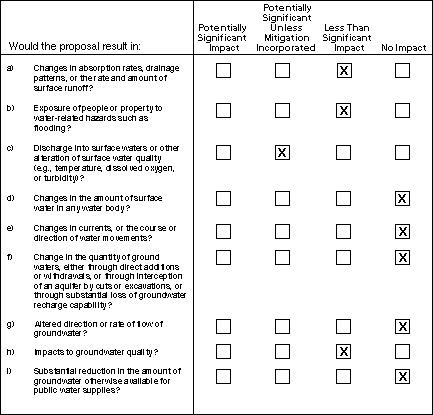IV. WATER

- The project site is located on approximately 3.87 acres, much of it is currently paved with asphalt. Currently, drainage at the site occurs as sheetflow runoff, draining along a gentle gradient to the southwest portion of the site. Construction of the substation will require removal of some of the pavement and replacing the pavement with a crushed rock surface. This will tend to increase the net infiltration rate at the site and will result in a slightly smaller amount of surface runoff. The site development will not significantly alter drainage patterns and will result in a less than significant impact.
- The site is within the 100-year floodplain of the Petaluma River (Zone AO) (FEMA, 1989) and is subject to an estimated two feet of inundation during the 100-year flood (PG&E, 1997). The project does not include walled and roofed buildings intended for human occupancy, nor does the project include gas or liquid storage tanks. The facilities will be supported on concrete slabs that will extend 6 to 8 inches above grade. These slabs may be inundated during the 100 year flood. The switchgear will be supported on a raised slab above the inundation level so that the substation will remain operational during potential inundation (PG&E, 1998a). The exposure of people and property to potential flood hazards is considered to be a less than significant impact.
- The transformers will contain up to 16,000 gallons of mineral oil coolant. The project includes construction of a pond designed to contain 100 percent of the maximum spill volume. The pond design, maintenance, and inspection requirements would be in accordance with Environmental Protection Agency Code of Federal Regulations Spill Prevention Control and Countermeasures. Use of these measures would result in a less-than-significant impact.
In addition to potential transformer spills, there could be discharges of pollutants and sediment during construction. Potential pollutants include fuels, brake fluids, coolants, and lubricants from construction equipment. Sediments could potentially be discharged from erosion of disturbed soils. The erosion potential is considered to be small because the site is nearly flat, however, loosened soil could become entrained in runoff and discharged off-site. Construction of the connector line poles and installation of landscaping would occur adjacent to a flood drainage structure along the north side of Corona Road and silt and pollutants could be directed into that channel. The impact is potentially significant, but mitigable to a less than significant level.
Mitigation
The following mitigation measure would reduce the potential impact of surface water discharge to a less-than-significant level.
Mitigation Measure IV.c.1. If construction is scheduled during the rainy season, PG&E shall employ best construction management practices to prevent discharges of silt and other substances from construction into storm drains. PG&E shall develop and implement a plan to control excavated soils and runoff, specifying practices such as the use of detention basins, straw bales, silt fences or other deterrents, and site clean-up procedures and practices to minimize contact of construction materials with stormwater. PG&E shall file a copy of the plan with the CPUC and shall certify compliance with this measure in progress reports to the CPUC.
- There are no water bodies on the site. The project includes construction of a facility to pond and contain runoff from the substation area in the event of a transformer spill. This feature would contain water only temporarily after storms. There would not be any significant change in the amount of water in any water body.
- There are no water courses on the site. The project would not impact the flow of natural drainage courses. The project includes landscaping to convert the drainage channel on the northern side of Corona Road to an urban drainage facility. The proposed riparian vegetation plantings would not impede the functions of the drainage channel.
- Groundwater is encountered at a depth of 5 to 7 feet at the site (PG&E, 1998). The project would not require removal of groundwater, either during construction or operation. The City of Petaluma will supply water. The project will include removal of some impervious pavement, which could cause a very small increase in infiltration. The effect of the project on groundwater is considered to be negligible.
- The project will not significantly affect groundwater conditions at the site. There are no deep excavations planned that would intercept groundwater. Trenches greater than 5 feet deep may intercept groundwater; however, the effect on groundwater flow is considered to be negligible.
- The compacted fills, clayey surface soils, and impervious surfaces will prevent significant infiltration of contaminants. The project includes construction of a facility to pond and contain potential transformer spills of mineral oils. The pond facility will be lined to prevent contaminant infiltration. The effect of the project on groundwater quality is considered to be less than significant.
- The proposed project would not use groundwater and would have no effect on local groundwater use.
TOP

